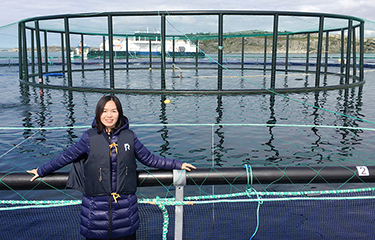The global seafood industry is not adapting fast enough to the bevy of threats it faces due to climate change, a Blue Food Assessment study has found.
Climate change is the biggest problem barreling down on the industry, but pollution and overfishing also loom large, according to "Vulnerability of Blue Foods to Human-induced Environmental Change,” published 26 June in Nature Sustainability. It is one of seven scientific papers being authored by the Blue Food Assessment, an effort led by Stanford University’s Center for Ocean Solutions and Center on Food Security and the Environment; the Stockholm Resilience Centre at Stockholm University; and EAT, a nonprofit dedicated to food-system transformation, pushing to better understand the role of so-called “blue foods” in global food systems.
Global warming is causing species migration and invasion, algal blooms, hotter water temperatures, and rising sea levels, all preeminent threats to the world’s aquaculture and fishing sectors. The study found wild-catch fisheries were generally more vulnerable to climate-related stressors, particularly rising temperatures and acidification, while aquaculture was more susceptible to the effects of diseases and hypoxia, or low oxygen levels, according to Phys.org.
"Although we have made some progress with climate change, our adaptation strategies for blue food systems facing environmental change are still underdeveloped and need urgent attention," Stockholm Resilience Center Researcher Rebecca Short, one of the paper’s lead authors, said.
The published study included a ranking of countries by their exposure to 17 key stressors identified by the authors, with China, Japan, India, and Vietnam – which collectively account for 45 percent of global seafood landings and 85 percent of aquaculture production – each deemed at the highest risk. Developing countries, including Bangladesh, Togo, and Honduras, are at the greatest risk since they have the lowest capacity for adaptation, the study found.
“These countries are more likely to suffer from environmental disturbances and should prioritize both impact mitigation and capacity building in terms of improved governance, economy and social development to enable more resilient blue food production,” the study found. “In these countries, diversification of production (for example, expanding aquaculture in regions where it is still nascent and has low estimated impact) will be necessary unless sufficient mitigation and adaptation strategies are implemented.”
In Thailand, the country’s huge shrimp-farming segment “substantial climate and disease risks,” according to the study.
“[It] requires not only technological innovation in farming, but also risk-sharing strategies, such as price contracts and insurance,” the study found.
Even developed countries such as the United States and Norway are not immune to the environmental threats identified in the study.
“Across these countries, high exposure to inland eutrophication, inland warming, altered precipitation, and sea level rise was mostly common,” the study found.
Xiamen University State Key Laboratory of Marine Environmental Science Professor Ling Cao, another of the study’s lead authors, said the current body of global research is still lacking in providing a thorough understanding of the impact of climate change and other environmental problems on the seafood industry due to their complexity.
"We have only scratched the surface in our understanding of how environmental stressors are connected, and how they can both negatively impact the production and safety of the resulting blue foods," Ling said. "Understanding the complexity of these stressors, and their cascading impacts, will be essential in developing successful adaptation and mitigation strategies.”
University of California, Santa Barbara Professor and National Center for Ecological Analysis and Synthesis Director Ben Halpern, a study co-lead author, said while the lists of country-by-country impacts are an important means of delineating the impact of changing environmental conditions on different populations, the problem needs to be addressed globally.
"Environmental stressors do not care about national borders," Halpern said. "Stressors get moved by air, water, species, and humans, connecting land to sea and ecosystem to ecosystem."
Halpern called for more transboundary collaboration and adaptation strategies, and greater stakeholder engagement in studying the problems facing the seafood sector and working together to form and implement solutions.
Photo courtesy of The Pew Charitable Trusts







